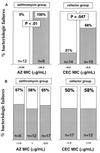Bacteriologic efficacies of oral azithromycin and oral cefaclor in treatment of acute otitis media in infants and young children
- PMID: 10602721
- PMCID: PMC89626
- DOI: 10.1128/AAC.44.1.43-50.2000
Bacteriologic efficacies of oral azithromycin and oral cefaclor in treatment of acute otitis media in infants and young children
Abstract
A prospective, open-label, randomized study was conducted in order to determine the bacteriologic efficacies of cefaclor and azithromycin in acute otitis media (AOM). Tympanocentesis was performed on entry into the study and 3 to 4 days after initiation of treatment. Bacteriologic failure after 3 to 4 days of treatment with both drugs occurred in a high proportion of culture-positive patients, especially in those in whom AOM was caused by Haemophilus influenzae (16 of 33 [53%] of those treated with azithromycin and 13 of 34 [52%] of those treated with cefaclor). Although a clear correlation of the persistence of the pathogen with increased MICs of the respective drugs could be demonstrated for Streptococcus pneumoniae, no such correlation was found for H. influenzae. It is proposed that susceptibility breakpoints for H. influenzae should be considerably lower than the current ones for both cefaclor and azithromycin for AOM caused by H. influenzae.
Figures




Comment in
-
Establishing criteria for assessment of efficacy of antimicrobial agents in acute otitis media.Antimicrob Agents Chemother. 2000 Sep;44(9):2590-2. doi: 10.1128/AAC.44.9.2590-2592.2000. Antimicrob Agents Chemother. 2000. PMID: 11012390 Free PMC article. No abstract available.
References
-
- Appelbaum P C. Antimicrobial resistance in Streptococcus pneumoniae: an overview. Clin Infect Dis. 1992;15:77–83. - PubMed
-
- Aronovitz C. A multicenter open label trial of azithromycin vs. amoxicillin clavulanate for the management of acute otitis media in children. Pediatr Infect Dis J. 1996;15:S15–S19. - PubMed
-
- Austrian R. The Quellung reaction, a neglected microbiologic technique. Mt Sinai J Med. 1976;43:669–705. - PubMed
-
- Baquero F, Martinez-Beltran J, Loza R. A review of antibiotic resistance patterns of Streptococcus pneumoniae in Europe. J Antimicrob Chemother. 1991;28(Suppl. C):31–38. - PubMed
-
- Barnett E D, Klein J O. The problem of resistant bacteria for the management of acute otitis media. Pediatr Clin N Am. 1995;42:509–517. - PubMed
Publication types
MeSH terms
Substances
LinkOut - more resources
Full Text Sources
Medical

